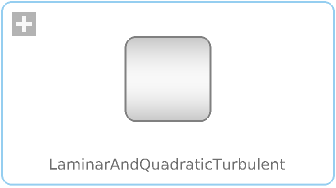WOLFRAM SYSTEM MODELER
LaminarAndQuadraticTurbulentPipe wall friction for laminar and turbulent flow in circular tubes (simple characteristic) |
|
Package Contents
|
Return mass flow rate m_flow as function of pressure loss dp, i.e., m_flow = f(dp), due to wall friction |
|
|
Return pressure loss dp as function of mass flow rate m_flow, i.e., dp = f(m_flow), due to wall friction |
|
|
Return mass flow rate m_flow as function of pressure loss dp, i.e., m_flow = f(dp), due to wall friction and static head |
|
|
pressureLoss_m_flow_staticHead Return pressure loss dp as function of mass flow rate m_flow, i.e., dp = f(m_flow), due to wall friction and static head |
|
|
Functions to calculate mass flow rate from friction pressure drop and vice versa |
Package Constants (6)
| use_mu |
Value: true Type: Boolean Description: = true, if mu_a/mu_b are used in function, otherwise value is not used |
|---|---|
| use_roughness |
Value: true Type: Boolean Description: = true, if roughness is used in function, otherwise value is not used |
| use_dp_small |
Value: true Type: Boolean Description: = true, if dp_small is used in function, otherwise value is not used |
| use_m_flow_small |
Value: true Type: Boolean Description: = true, if m_flow_small is used in function, otherwise value is not used |
| dp_is_zero |
Value: false Type: Boolean Description: = true, if no wall friction is present, i.e., dp = 0 (function massFlowRate_dp() cannot be used) |
| use_Re_turbulent |
Value: true Type: Boolean Description: = true, if Re_turbulent input is used in function, otherwise value is not used |
Information
This information is part of the Modelica Standard Library maintained by the Modelica Association.
This component defines the quadratic turbulent regime of wall friction: dp = k*m_flow*|m_flow|, where "k" depends on density and the roughness of the pipe and is no longer a function of the Reynolds number. This relationship is only valid for large Reynolds numbers. At Re=4000, a polynomial is constructed that approaches the constant λ (for large Reynolds-numbers) at Re=4000 smoothly and has a derivative at zero mass flow rate that is identical to laminar wall friction.
Wolfram Language

SystemModel["Modelica.Fluid.Pipes.BaseClasses.WallFriction.LaminarAndQuadraticTurbulent"]

